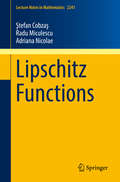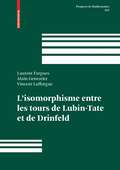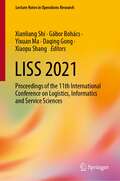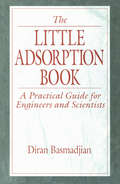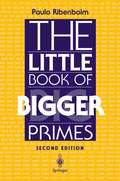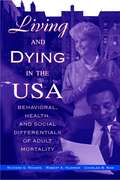- Table View
- List View
Liouville-Riemann-Roch Theorems on Abelian Coverings (Lecture Notes in Mathematics #2245)
by Minh Kha Peter KuchmentThis book is devoted to computing the index of elliptic PDEs on non-compact Riemannian manifolds in the presence of local singularities and zeros, as well as polynomial growth at infinity. The classical Riemann–Roch theorem and its generalizations to elliptic equations on bounded domains and compact manifolds, due to Maz’ya, Plameneskii, Nadirashvilli, Gromov and Shubin, account for the contribution to the index due to a divisor of zeros and singularities. On the other hand, the Liouville theorems of Avellaneda, Lin, Li, Moser, Struwe, Kuchment and Pinchover provide the index of periodic elliptic equations on abelian coverings of compact manifolds with polynomial growth at infinity, i.e. in the presence of a "divisor" at infinity.A natural question is whether one can combine the Riemann–Roch and Liouville type results. This monograph shows that this can indeed be done, however the answers are more intricate than one might initially expect. Namely, the interaction between the finite divisor and the point at infinity is non-trivial.The text is targeted towards researchers in PDEs, geometric analysis, and mathematical physics.
Lipschitz Functions (Lecture Notes in Mathematics #2241)
by Ştefan Cobzaş Radu Miculescu Adriana NicolaeThe aim of this book is to present various facets of the theory and applications of Lipschitz functions, starting with classical and culminating with some recent results. Among the included topics we mention: characterizations of Lipschitz functions and relations with other classes of functions, extension results for Lipschitz functions and Lipschitz partitions of unity, Lipschitz free Banach spaces and their applications, compactness properties of Lipschitz operators, Bishop-Phelps type results for Lipschitz functionals, applications to best approximation in metric and in metric linear spaces, Kantorovich-Rubinstein norm and applications to duality in the optimal transport problem, Lipschitz mappings on geodesic spaces.The prerequisites are basic results in real analysis, functional analysis, measure theory (including vector measures) and topology, which, for reader's convenience, are surveyed in the first chapter of the book.
L'isomorphisme entre les tours de Lubin-Tate et de Drinfeld (Progress in Mathematics #262)
by Laurent Fargues Alain Genestier Vincent LafforgueCe livre contient une démonstration détaillée et complète de l'existence d'un isomorphisme équivariant entre les tours p-adiques de Lubin-Tate et de Drinfeld. Le résultat est établi en égales et inégales caractéristiques. Il y est également donné comme application une démonstration du fait que les cohomologies équivariantes de ces deux tours sont isomorphes, un résultat qui a des applications à l'étude de la correspondance de Langlands locale. Au cours de la preuve des rappels et des compléments sont donnés sur la structure des deux espaces de modules précédents, les groupes formels p-divisibles et la géométrie analytique rigide p-adique. This book gives a complete and thorough proof of the existence of an equivariant isomorphism between Lubin-Tate and Drinfeld towers in infinite level. The result is established in equal and inequal characteristics. Moreover, the book contains as an application the proof of the equality between the equivariant cohomology of both towers, a result that has applications to the local Langlands correspondence. Along the proof background and complements are given on the structure of both moduli spaces, p-divisible formal groups and p-adic rigid analytic geometry.
LISP-STAT: An Object-Oriented Environment for Statistical Computing and Dynamic Graphics (Wiley Series in Probability and Statistics #353)
by Luke TierneyWritten for the professional statistician or graduate statistics student, the primary objective of this book is to describe a system, based on the LISP language, for statistical computing and dynamic graphics to show how it can be used as an effective platform for a wide range of statistical computing tasks ranging from basic calculations to customizing dynamic graphs. In addition, it introduces object-oriented programming and graphics programming in a statistical context. The discussion of these ideas is based on the Lisp-Stat system; readers with access to such a system can reproduce the examples presented and use them as a basis for further experimentation and study.
LISS 2021: Proceedings of the 11th International Conference on Logistics, Informatics and Service Sciences (Lecture Notes in Operations Research)
by Xianliang Shi Xiaopu Shang Gábor Bohács Daqing Gong Yixuan MaThis book aims to provide new research methods, theories and applications from various areas of management and engineering. In detail, the included scientific papers analyze and describe communication processes in the fields of logistics, informatics, service sciences and other related areas. The variety of the papers delivers added value for both scholars and practitioners. Information and communication technologies have been providing an effective network infrastructure and development platform for logistics and service operations. To meet the needs of consumers and to promote core competences, many institutions and firms have been developing new types of services. This proceeding focus on “AI and data driven technical and management innovation in logistics, informatics and services.” In detail, the included scientific papers analyze the latest fundamental advances in the state of the art and practice of logistics, informatics, service operations and service science. This book is the documentation of the conference “11th International Conference on Logistics, Informatics and Service Sciences,” which took place at the Shandong University. Due to the impact of COVID-19, LISS 2021 took place online as a virtual conference.
A List of Successes That Can Change the World: Essays Dedicated to Philip Wadler on the Occasion of His 60th Birthday (Lecture Notes in Computer Science #9600)
by Sam Lindley Conor McBride Phil Trinder Don SannellaThis volume is published in Honor of Philip Wadler on the occasion of his 60th birthday, and the collection of papers form a Festschrift for him. The contributions are made by some of the many who know Phil and have been influenced by him. The research papers included here represent some of the areas in which Phil has been active, and the editors thank their colleagues for agreeing to contribute to this Festschrift. We attempt to summarize Phil Wadler's scientific achievements. In addition, we describe the personal style and enthusiasm that Phil has brought to the subject.
Lit and Dark Liquidity with Lost Time Data: Interlinked Trading Venues Around The Global Financial Crisis
by T. VuorenmaaSince the 2008 financial crisis, researchers and policy makers have been looking to empirical data to distil both what happened and how a similar event can be avoided in the future. In Lit and Dark Liquidity with Lost Time Data, Vuorenmaa analyses liquidity to better understand the crux of the financial crisis. By relating liquidity to jump activity, market microstructure noise variance, and average pairwise correlation, Vuorenmaa uncovers the dynamics and ramifications behind anonymous trades made outside of public exchanges, and measures its impact on the crisis. This volume is ideal for academics, students, and practitioners alike, who are interested in investigating the role of lost time in and after the recession.
Literary Heterogenesis: Diagrammatic Dynamics. The Interplay Between the Virtual and the Actual (Lecture Notes in Morphogenesis)
by Noëlle BattThis book advances a new interdisciplinary approach that engages with the concepts of science and literature through the mediation of philosophy (with a focus on the ideas of Gilbert Simondon and Gilles Deleuze). It investigates in innovative ways the multifaceted dimensions of creation, of genesis, considered here in artistic and mathematical terms as “heterogenesis”. The dialogic interaction among the three domains generates a renewed analysis of poems selected in the work of particularly inventive poets, both French and American—Emily Dickinson, e.e. cummings and Francis Ponge—as well as the artwork of Pierre Soulages, Anna-Eva Bergman and Cy Twombly. Literary Heterogenesis. Diagrammatic Dynamics. The Interplay of the Virtual and the Actual will interest specialists of mathematics, physics, literary theory and criticism, philosophy, and epistemology. It will also attract any curious mind drawn to the bridging of disciplines and the concepts of the two cultures.
The Literature and Study of Urban and Regional Planning (Routledge Revivals)
by Brenda WhiteFirst published in 1974, The Literature and Study of Urban and Regional Planning discusses the processes of spatial planning and the range of subject knowledge which is required to contribute to it. It describes the physical forms in which the literature relating to spatial planning is usually presented and the ways in which this literature is made available in different types of organization. The author gives details of the most useful libraries whose facilities are available to students, and of the research which is being undertaken into the principal problems of planning information. The second part of the book consists of a subject bibliography, divided for ease of reference into twenty-six sections each concerned with a component part of spatial planning and containing annotated references to books, official publications, developmental plans, legislation, and other material. This book will be of interest to students of sociology and urban studies.
The Literature and Study of Urban and Regional Planning (Routledge Revivals)
by Brenda WhiteFirst published in 1974, The Literature and Study of Urban and Regional Planning discusses the processes of spatial planning and the range of subject knowledge which is required to contribute to it. It describes the physical forms in which the literature relating to spatial planning is usually presented and the ways in which this literature is made available in different types of organization. The author gives details of the most useful libraries whose facilities are available to students, and of the research which is being undertaken into the principal problems of planning information. The second part of the book consists of a subject bibliography, divided for ease of reference into twenty-six sections each concerned with a component part of spatial planning and containing annotated references to books, official publications, developmental plans, legislation, and other material. This book will be of interest to students of sociology and urban studies.
Litre to gallon conversion graph (large print)
by RnibThis page shows a line graph. There is a locator dot shown, which will be at the top left when the image is the correct way up. The Y-axis on the left of the page is litres going from 0 to 25 labelled every five litres. The X-axis at the bottom of the page is gallons going from 0 to 5 labelled every gallon. There is a grid of fine dotted lines to aid reading the graph. The data line is straight and goes diagonally up and right. Two readings are shown by a heavy dashed line. They show that 15 litres is about 3.25 gallons and that 5 gallons is about 23 litres.
Litre to gallon conversion graph (UEB contracted)
by RnibThis page shows a line graph. There is a locator dot shown, which will be at the top left when the image is the correct way up. The Y-axis on the left of the page is litres going from 0 to 25 labelled every five litres. The X-axis at the bottom of the page is gallons going from 0 to 5 labelled every gallon. There is a grid of fine dotted lines to aid reading the graph. The data line is straight and goes diagonally up and right. Two readings are shown by a heavy dashed line. They show that 15 litres is about 3.25 gallons and that 5 gallons is about 23 litres.
Litre to gallon conversion graph (UEB uncontracted)
by RnibThis page shows a line graph. There is a locator dot shown, which will be at the top left when the image is the correct way up. The Y-axis on the left of the page is litres going from 0 to 25 labelled every five litres. The X-axis at the bottom of the page is gallons going from 0 to 5 labelled every gallon. There is a grid of fine dotted lines to aid reading the graph. The data line is straight and goes diagonally up and right. Two readings are shown by a heavy dashed line. They show that 15 litres is about 3.25 gallons and that 5 gallons is about 23 litres.
The Little Adsorption Book: A Practical Guide for Engineers and Scientists
by Diran BasmadjianThis unique approach to the basic concepts of adsorption is written for students, engineers, scientists, and others who need a clear presentation of adsorption processes. Unlike other texts on this subject, which are written for the specialist and rely heavily on advanced mathematics, this unique book helps you solve everyday problems in applications of adsorption, without complex mathematics or computers.The author, a recognized expert in the field, gives you a quick introduction to the underlying physics of absorption and explains how to apply adsorption to solve analytical and design problems. Rich with practical examples and enhanced by illustrations that support the text, this refreshingly straightforward presentation helps you cut through the complexities of adsorption to find fast answers to pressing real-world questions.
The Little Book of Bigger Primes
by Paulo RibenboimThis book could have been called "Selections from the Book of Prime Number Records." However, I prefered the title which propelled you on the first place to open it, and perhaps (so I hope) to buy it! Richard K. Guy, with his winning ways, suggested the title to me, and I am grateful. But the book isn't very different from its parent. Like a bonsai, which has all the main characteristics of the full-sized tree, this little paperback should exert the same fatal attraction. I wish it to be as dangerous as the other one, in the saying of John Brillhart. I wish that you, young student, teacher or retired mathematician, engineer, computer buff, all of you who are friends of numbers, to be driven into thinking about the beautiful theory of prime numbers, with its inherent mystery. I wish you to exercise your brain and fingers-not vice-versa. But I do not wish you, specialist in number theory to look at this little book-most likely you have been eliminated from this shorter version-what a terrible feeling. But do not cry, you had your book already. This one is for those who will be taking over and should put their steps forward, mostly little, occasionally giant, to develop the science of numbers. Paulo Ribenboim Contents Preface vii Guiding the Reader xii Index of Notations xiii Introduction 1 1 How Many Prime Numbers Are There? 3 I. Euclid's Proof .. 3 11. Kummer's Proof 4 II. P6lya's Proof . .
The Little Book of Bigger Primes
by Paulo RibenboimA deep understanding of prime numbers is one of the great challenges in mathematics. In this new edition, fundamental theorems, challenging open problems, and the most recent computational records are presented in a language without secrets. The impressive wealth of material and references will make this book a favorite companion and a source of inspiration to all readers. Paulo Ribenboim is Professor Emeritus at Queen's University in Canada, Fellow of the Royal Society of Canada, and recipient of the George Pólya Award of the Mathematical Association of America. He is the author of 13 books and more than 150 research articles. From the reviews of the First Edition: Number Theory and mathematics as a whole will benefit from having such an accessible book exposing advanced material. There is no question that this book will succeed in exciting many new people to the beauty and fascination of prime numbers, and will probably bring more young people to research in these areas. (Andrew Granville, Zentralblatt)
A Little Book of Martingales (Texts and Readings in Mathematics #86)
by Arup Bose Arijit Chakrabarty Rajat Subhra HazraThis concise textbook, fashioned along the syllabus for master’s and Ph.D. programmes, covers basic results on discrete-time martingales and applications. It includes additional interesting and useful topics, providing the ability to move beyond. Adequate details are provided with exercises within the text and at the end of chapters. Basic results include Doob’s optional sampling theorem, Wald identities, Doob’s maximal inequality, upcrossing lemma, time-reversed martingales, a variety of convergence results and a limited discussion of the Burkholder inequalities. Applications include the 0-1 laws of Kolmogorov and Hewitt–Savage, the strong laws for U-statistics and exchangeable sequences, De Finetti’s theorem for exchangeable sequences and Kakutani’s theorem for product martingales. A simple central limit theorem for martingales is proven and applied to a basic urn model, the trace of a random matrix and Markov chains. Additional topics include forward martingale representation for U-statistics, conditional Borel–Cantelli lemma, Azuma–Hoeffding inequality, conditional three series theorem, strong law for martingales and the Kesten–Stigum theorem for a simple branching process. The prerequisite for this course is a first course in measure theoretic probability. The book recollects its essential concepts and results, mostly without proof, but full details have been provided for the Radon–Nikodym theorem and the concept of conditional expectation.
The Little Book of Math into English
by George GrätzerThis colorful and concise little book is uniquely tailored for those who write mathematical texts at any level and are eager to improve their English writing skills. The easy-to-read guide focuses on helping the writer avoid common English mistakes in mathematical writing. With just a few minutes of engaging, light reading each day, the reader will learn to create clearer, more readable, math texts. The book covers 23 crucial topics, ranging from correct article and preposition usage to proper usage of dashes, conjunctions, and prepositions. It also addresses the construction of direct sentences, effective introductory phrases for formulas, and more. As a bonus to the reader, ‘Practice makes perfect’ exercises relating to each topic are freely accessible on this book’s Springer website. Appendix A gives a quick tutorial on grammatical terms and constructs. Appendix B looks at ChatGPT and the positive aspects of its powerful capabilities. Additionally, Paul Halmos’s article on ‘How to write mathematics’ is included in Appendix C. It deals with the mathematical aspects of writing.
A Little Guide for Teachers: Using Student Data (A Little Guide for Teachers)
by Richard SelfridgeStudent data can be one of the most powerful tools a teacher can use to help their students to learn. In this book, Richard Selfridge offers practical advice for teachers on how to gather useful student data in the classroom and how to use these findings effectively to enhance your teaching. The Little Guide for Teachers series is little in size but BIG on all the support and inspiration you need to navigate your day-to-day life as a teacher. Authored by experts in the field Easy to dip in-and-out of Interactive activities encourage you to write into the book and make it your own Read in an afternoon or take as long as you like with it!
A Little Guide for Teachers: Using Student Data (A Little Guide for Teachers)
by Richard SelfridgeStudent data can be one of the most powerful tools a teacher can use to help their students to learn. In this book, Richard Selfridge offers practical advice for teachers on how to gather useful student data in the classroom and how to use these findings effectively to enhance your teaching. The Little Guide for Teachers series is little in size but BIG on all the support and inspiration you need to navigate your day-to-day life as a teacher. Authored by experts in the field Easy to dip in-and-out of Interactive activities encourage you to write into the book and make it your own Read in an afternoon or take as long as you like with it!
A Little Guide for Teachers: Using Student Data (A Little Guide for Teachers)
by Richard SelfridgeStudent data can be one of the most powerful tools a teacher can use to help their students to learn. In this book, Richard Selfridge offers practical advice for teachers on how to gather useful student data in the classroom and how to use these findings effectively to enhance your teaching. The Little Guide for Teachers series is little in size but BIG on all the support and inspiration you need to navigate your day-to-day life as a teacher. Authored by experts in the field Easy to dip in-and-out of Interactive activities encourage you to write into the book and make it your own Read in an afternoon or take as long as you like with it!
Littlewood-Paley and Multiplier Theory (Ergebnisse der Mathematik und ihrer Grenzgebiete. 2. Folge #90)
by R. E. Edwards G. I. GaudryThis book is intended to be a detailed and carefully written account of various versions of the Littlewood-Paley theorem and of some of its applications, together with indications of its general significance in Fourier multiplier theory. We have striven to make the presentation self-contained and unified, and adapted primarily for use by graduate students and established mathematicians who wish to begin studies in these areas: it is certainly not intended for experts in the subject. It has been our experience, and the experience of many of our students and colleagues, that this is an area poorly served by existing books. Their accounts of the subject tend to be either ill-suited to the needs of a beginner, or fragmentary, or, in one or two instances, obscure. We hope that our book will go some way towards filling this gap in the literature. Our presentation of the Littlewood-Paley theorem proceeds along two main lines, the first relating to singular integrals on locally com pact groups, and the second to martingales. Both classical and modern versions of the theorem are dealt with, appropriate to the classical n groups IRn, ?L , Tn and to certain classes of disconnected groups. It is for the disconnected groups of Chapters 4 and 5 that we give two separate accounts of the Littlewood-Paley theorem: the first Fourier analytic, and the second probabilistic.
Liutex and Third Generation of Vortex Definition and Identification: An Invited Workshop from Chaos 2020
by Chaoqun Liu Yiqian WangThis book collects papers presented in the Invited Workshop, “Liutex and Third Generation of Vortex Definition and Identification for Turbulence,” from CHAOS2020, June 9-12, 2020, which was held online as a virtual conference. Liutex is a new physical quantity introduced by Prof. Chaoqun Liu of the University of Texas at Arlington. It is a vector and could give a unique and accurate mathematical definition for fluid rotation or vortex. The papers in this volume include some Liutex theories and many applications in hydrodynamics, aerodynamics and thermal dynamics including turbine machinery. As vortex exists everywhere in the universe, a mathematical definition of vortex or Liutex will play a critical role in scientific research. There is almost no place without vortex in fluid dynamics. As a projection, the Liutex theory will play an important role on the investigations of the vortex dynamics in hydrodynamics, aerodynamics, thermodynamics, oceanography, meteorology, metallurgy, civil engineering, astronomy, biology, etc. and to the researches of the generation, sustenance, modelling and controlling of turbulence.
Living and Dying in the USA: Behavioral, Health, and Social Differentials of Adult Mortality
by Richard G. Rogers Robert A. Hummer Charles B. NamThe simplicity of using one data set in addressing the relationship of single variables to mortality distinguishes Living and Dying in the USA from other recent investigations of mortality. The authors use the recently released National Health Interview Survey and the National Death Index to make a definitive statement about demographics and mortality. By surveying demographic and sociocultural characteristics associated with mortality, socioeconomic effects, health-related conditions, and health status, they reveal connections among several factors related to mortality chances. Easily understood and cited, their study emphasizes the statistical methods underlying their revelations and invites readers to duplicate their results.Comprehensive coverage of US adult mortality differentialsBased on a new and innovative data setIncludes factors rarely examined in related mortality researchNot only documents mortality differentials, but explores explanations for themExtensive list of references associated with each chapterConsistent, straightforward methodology used throughout aids readers in both understanding the content and in comparing results from chapter to chapter
Living Longer and Healthier at Older Ages: A Longitudinal Analysis of Chinese Oldest Old’s Health and Its Determinants (Advances in Studies of Aging and Health #3)
by Li ZhangThis book analyzes data from eight waves (1998, 2000, 2002, 2005, 2008, 2011-12, 2014 and 2018) of the Chinese Longitudinal Healthy Longevity Surveys (CLHLS) to explore how health status of the Chinese oldest old has changed over time and across birth cohorts. It also intends to investigate how period and birth cohorts have played a role in the associations between Chinese oldest old’s health and a variety of demographic, socioeconomic, and lifestyle factors. The book applies the age-period-cohort (APC) approach and constructs cross-classified random-effects models (CCREMs) to carry out the analyses. The oldest old’s health is measured by self-rated health (SRH), chronic diseases, cognitive function and subjective wellbeing which is indicated by positive and negative feeling scores. The results show that Chinese oldest old’s health status has changed over time and across birth cohorts. Significant period and cohort effects are shown when linking Chinese oldest old’s health to various demographic, socioeconomic and health lifestyle covariates. In general, period effects surpass the cohort effects. Particularly, the oldest old’s subjective wellbeing is more likely to be influenced by period than cohort effects. Period changes caused by social events, such as economic hardship and natural disasters, have left strong imprints on Chinese oldest old’s mental than physical health status. Based on these findings, the book highlights some important policy implications and points out future research directions to improve the current study. It provides an interesting read for researchers in gerontology and public health studies. It is also of interest to general audience, including practitioners in health care and policy makers who are interested in old age care and healthy aging policies.

